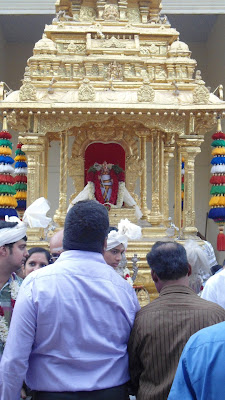 |
| Lord Muruga, - Utchavamoorthy, Maruthamalai |
The
ancient past of the temple can be traced to the period of Sage Kachyapar's
PERUR PURANAM. The origin of the temple is rooted in legendary antiquity and
dates back to the age of Surapadama, the demon destroyed by Lord Subramanya
referred to in SKANDAPURNAM. Evidance of existence of this temple has been
found in the inscriptions of Thirumuruganathaswami Temple, Thirumurganpoondi to
12th century A.D.
According to Perurpuranam, unable to bear the agony and
anguish of Soorapadama, the scourge of the gods aided by his mighty brothers,
Singamukha and Tharaka, the gods approached Lord Siva and sought His succour.
Lord Siva comforted the Gods that Lord Muruga would come to their rescue, root
out and destroy Surapadama and his aides. The gods should hurry to the
Marudhamalai Hills and await the arrival of Lord Muruga, their Saviour!
Perupuranam also alludes to a king called Kusathvajan, who, it is said, was
blessed with a male issue, only after worshipping Marudhamalai Muruga.
 |
| Temple Entrance - Maruthamalai |
The
Divine Cow Kamadhenu(Komatha) is reported to have grazed in the pastures of the
hills of Marudhamalai.
 |
| Main Shrine - Maruthamalai |
In the temple premises, we can find Aathimoolasthanam, Edumban temple, Kuthirai Kulampadigal, abodes of Siddhas - Pambatti Siddhar and Pancha Vrutcham( 5 entangled divine trees).
 |
| Raja gopuram at dusk |
Aathimoolasthanam
As we approach the hill top present is the prime shrine were Lord Subramanya with his two consorts, Valli and Teyvannai, enshrined in the form of linga .The first pooja is performed for these deities.
Edumaban temple
In
the shrine of Idumba the image of the deity is carved on a huge round rock in
the posture of carrying a Kaavadi. Married couples having no issues worship the
deity and offer toy cradles with the firm faith of being blessed with progeny
by the Grace of god.
Pancha Virutcham
Under the cluster of trees entangled with one another. is an Idol of Lord Ganesha - Heramba Ganapathy. The breeze wafting along the foliage has an unfailing cure for all diseases of the people. A host of saints, invisible to the common man's eyes, are supposed to dwell here doing meditation. An aged Irula tribesman, 80 years old identified the entangled trees as Korakattai, Ichi, Banyan, Vakkanai and Ottu maram and added there was one tree in the group, Peepal in the days of yore, and it is extinct now. The tribalman also said that this tree existed in the same manner even during his childhood. This is a unique phenomenon which has attracted botanists apart from devotees.
Kuthirai Kulambadiagal
Continuing
our ascent, we find a beautiful mandapam, enshrining what is called 'Kudirai
Kulambu' (hoof marks of the horse). It is believed that the horse of Lord
Muruga caused the marks, as he marched against the Demon Surapadma or the horse
on which Lord Muruga rode and chased the robbers referred to earlier might have
imprinted by them.
Pambatti Siddhar cave
The
Pambatti Siddhar Cave is another shrine drawing our attention. It is located on
the slopes towards the east and can be approached by a narrow path, protected
by a stone hedge or parapet. One can notice a natural image of a snake on the
rock. There is an underground passage from the cave to the primal shrine
through which the Pambati Siddhar wended his way everyday to worship Lord
Subramanya in the Company of his consorts .Pambatti Siddhar used this cave as
his abode for meditation on Lord Muruga and attained salvation here. A snake
comes to the cave everyday and feeds itself on the fruit and milk kept for it.
Devotees offer milk and fruit for the snake.
Golden Chariot of Lord Muruga
Golden chariot or car festival happens mostly in the evenings of Kiruthigai especially on Aadi Kiruthigai. The clippings here portrays the grandiose appearance of God of Youth smiling in the golden car wishing good luck to all his sincere devotees.
 |
| Lord Muruga - Magnificant look in Golden Chariot |
Where is Maruthamalai?
Maruthamalai is a small hill in Coimabatore 15KM away from Gandhipuram - the center of Coimbatore. Perurpuranam lists the three neighbouring hills, vellingiri, Nili and Marudhamalai as the very manifestations of Lord Siva, Parvathi and Subramanya respectively and the three hills taken together as the very symbol of Somaskanda.
Buses from Gandhipuram to Maruthamalai - 1, 1-B, 1-D, I-E, S-12, S-13, S-15, S-16, S-26, 46, 70, 70-A, 70-B, 76, 92
Note:
Siddhas are mystic philosophers who exercise their mental faculties to the utmost and attain godhead by means of meditation and reflection. They are endowed with incredible powers of the mind by which they perform great miracles and astound the common world. Siddhas can set at rest all their senses and awaken their spirit alone. Thus they are bodily asleep and spiritually awake. In this blessed mood they enter into a personal communion with god.
It is believed that there were 18 Siddha’s. One of the 18 siddha’s used to animate dead snakes and dance with him, so he was popularly known as Pambatti Siddhar. Pambatti Siddhar greatly revered in the Kongu region, he is credited with having lived in the company of snakes and made them dance to his tunes. Once, in the course of his wanderings, he chanced to meet one, Sattai Muni Siddhar, a contemporary and counterpart who initiated him into the art of entering into trances - the Jeeva Samadhi Nilai.
Once he transmigrated into the dead body of a king and performed great miracles. He composed songs of enlightenment. 'Siddharudam' is a work, attributed to his prophetic genius. Lord Muruga took joy in teasing and tantalizing the Siddha with his spiritual pranks. Once as an enormous boulder came down, rolling gaining momentum, the siddha tried to halt it, arrested its movement and averted a great havoc.


















